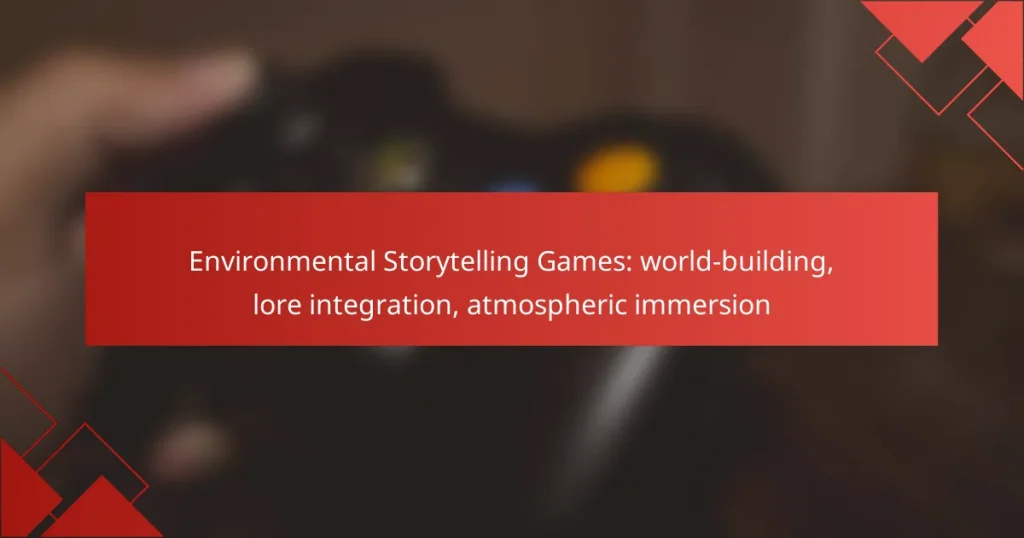Environmental storytelling games captivate players by crafting immersive worlds where lore and atmosphere intertwine seamlessly. Through visual and auditory cues, these games invite exploration and interaction, allowing players to uncover narratives embedded in their surroundings. By integrating lore into gameplay, they deepen player engagement and foster a profound connection to the game world.

What are the best environmental storytelling games?
The best environmental storytelling games immerse players in rich worlds filled with lore and atmosphere, allowing them to discover narratives through exploration and interaction. These games often rely on visual cues, environmental details, and subtle storytelling techniques to engage players in their unique settings.
The Legend of Zelda: Breath of the Wild
The Legend of Zelda: Breath of the Wild is renowned for its expansive open world and intricate environmental storytelling. Players uncover the history of Hyrule through ruins, hidden items, and NPC dialogues, creating a sense of discovery and connection to the land.
Exploration is rewarded with lore-rich shrines and environmental details that hint at past events, making the world feel alive. The game encourages players to piece together the narrative through their experiences, enhancing immersion.
Firewatch
Firewatch offers a unique narrative experience set in the Wyoming wilderness, where players assume the role of a fire lookout. The game uses its natural environment to convey emotions and story, with players uncovering a mystery through their interactions with the landscape and their supervisor via radio.
The atmospheric visuals and sound design create a sense of isolation and tension, drawing players into the unfolding narrative. The game effectively uses environmental cues to enhance storytelling, making each location feel significant.
What Remains of Edith Finch
What Remains of Edith Finch is a narrative-driven game that explores the lives of the Finch family through a series of vignettes. Each family member’s story is told in a unique environment, allowing players to experience their individual narratives through immersive gameplay mechanics.
The game excels in using its settings to reflect the emotions and themes of each story, creating a poignant exploration of family and loss. Players are encouraged to engage with the environment to uncover the family’s tragic history, enhancing the overall impact of the narrative.
Journey
Journey is a visually stunning game that emphasizes exploration and emotional connection through its vast desert landscape. Players traverse the environment, encountering other players in a shared experience, which adds depth to the storytelling.
The minimalist approach to narrative allows players to interpret their journey in personal ways, with the environment serving as a canvas for emotional expression. The game’s design encourages players to reflect on their experiences, making each journey unique and memorable.
Subnautica
Subnautica immerses players in an alien underwater world, where survival and exploration are key. The game’s environmental storytelling is conveyed through the ocean’s diverse ecosystems and the remnants of a crashed spaceship, inviting players to piece together the story of their surroundings.
Players discover lore through exploration, collecting data logs and interacting with the environment, which enhances the sense of immersion. The game’s atmospheric sound design and visuals create a captivating experience that emphasizes the beauty and danger of the underwater world.

How do environmental storytelling games enhance world-building?
Environmental storytelling games enhance world-building by creating rich, immersive settings that convey narrative through the environment itself. These games utilize visual and auditory cues to deepen player engagement and foster a sense of place, allowing players to explore lore and context organically.
Immersive environments
Immersive environments are crucial for effective world-building in storytelling games. They use detailed visuals, sound design, and interactive elements to create a believable world that draws players in. For example, a post-apocalyptic landscape filled with remnants of civilization can evoke emotions and curiosity, prompting players to uncover the story behind it.
To enhance immersion, developers should focus on cohesive design elements that reflect the game’s themes. This includes consistent art styles, atmospheric soundscapes, and environmental details that hint at the lore, such as graffiti or abandoned items that tell a story. Avoiding clutter and ensuring clarity in the environment can help players focus on the narrative.
Interactive narratives
Interactive narratives allow players to shape their experiences through choices and exploration, making the story feel personal and engaging. In environmental storytelling games, players often discover lore through environmental cues, such as notes, artifacts, or visual storytelling elements, rather than through traditional dialogue. This method encourages players to piece together the narrative themselves.
Developers should integrate interactive elements that reward exploration, such as hidden areas or lore-rich items that provide context to the world. This approach not only enhances player engagement but also encourages a deeper understanding of the game’s universe. However, it’s important to balance narrative depth with accessibility, ensuring that players can still follow the main story without feeling lost.
Player agency
Player agency refers to the degree of control players have over their actions and decisions within the game world. In environmental storytelling games, this agency is vital for fostering a sense of ownership and investment in the narrative. Players should feel that their choices impact the world around them, whether through direct actions or by influencing the unfolding story.
To maximize player agency, developers can implement branching storylines or multiple endings based on player decisions. This encourages replayability and allows players to explore different facets of the world. However, it’s essential to provide clear feedback on how choices affect the environment and narrative to avoid confusion and enhance the overall experience.

What role does lore integration play in gameplay?
Lore integration is crucial in gameplay as it enriches the narrative and provides a deeper understanding of the game world. By weaving lore into the gameplay experience, players become more invested in the story and characters, enhancing their overall enjoyment.
Deepens player engagement
Integrating lore into gameplay significantly deepens player engagement by creating a more immersive experience. When players encounter lore through environmental storytelling, such as books, artifacts, or dialogue, they feel a stronger connection to the game world. This engagement can lead to longer play sessions and increased exploration.
For instance, a game that includes hidden lore items encourages players to search every corner of the environment, fostering curiosity and investment in the narrative. Players are more likely to return to the game if they feel a personal connection to its story.
Provides context for actions
Lore integration provides essential context for player actions, making decisions feel more meaningful. When players understand the backstory and motivations behind their quests or challenges, they are more likely to appreciate the stakes involved. This context can transform routine tasks into significant moments within the narrative.
For example, if a player learns that a character’s family was harmed by a villain, their quest for revenge becomes more than just a mission; it becomes a personal journey. This understanding can enhance strategic thinking as players consider the implications of their choices.
Enhances emotional connection
Integrating lore into gameplay enhances emotional connections between players and characters, making the story more impactful. When players learn about a character’s struggles or triumphs through lore, they are more likely to empathize with them. This emotional investment can drive players to care about the outcomes of their actions.
Games that effectively use lore to develop character backstories often see players forming attachments to those characters, which can lead to a more memorable gaming experience. For instance, a character’s tragic past revealed through lore can evoke sympathy, motivating players to protect them throughout the game.

How do atmospheric elements contribute to immersion?
Atmospheric elements significantly enhance immersion by creating a believable and engaging environment that draws players into the game world. These elements, including sound design, visual aesthetics, and dynamic weather systems, work together to evoke emotions and reinforce the narrative experience.
Sound design
Sound design plays a crucial role in establishing the atmosphere of a game. By incorporating ambient sounds, such as rustling leaves, distant animal calls, or the hum of machinery, developers can create a rich auditory landscape that enhances the player’s sense of presence. Effective soundscapes can also signal changes in the environment or hint at nearby events, guiding player behavior.
To maximize immersion, consider using spatial audio techniques that allow players to perceive sound directionally. This can create a more realistic experience, as players can identify the source of sounds and react accordingly. Avoid overwhelming players with excessive noise; instead, focus on subtlety and variety to maintain engagement.
Visual aesthetics
Visual aesthetics encompass the art style, color palette, and overall design of the game world, all of which contribute to immersion. A cohesive visual style can evoke specific emotions and set the tone for the narrative. For instance, a dark, muted color scheme may create a sense of foreboding, while bright, vibrant colors can convey a sense of wonder.
When designing visuals, consider how lighting affects the atmosphere. Dynamic lighting can enhance realism and create mood shifts throughout the game. Additionally, incorporating environmental storytelling elements, such as ruins or artifacts, can deepen lore integration and encourage exploration.
Dynamic weather systems
Dynamic weather systems add an extra layer of realism and immersion by simulating changing environmental conditions. Features like rain, snow, fog, and wind can affect gameplay and player interactions, creating a more engaging experience. For example, heavy rain might reduce visibility and alter movement speed, prompting players to adapt their strategies.
Implementing weather changes that correlate with in-game events can further enhance immersion. For instance, a storm could signify a critical moment in the narrative, heightening tension. However, be mindful of performance impacts; ensure that weather effects are optimized to avoid lag or disruptions in gameplay.

What are the key criteria for selecting an environmental storytelling game?
When selecting an environmental storytelling game, consider story depth, visual quality, and gameplay mechanics. These criteria significantly influence the overall experience and immersion in the game world.
Story depth
Story depth refers to the richness and complexity of the narrative woven into the game. A well-developed story often includes intricate lore, character backstories, and meaningful quests that enhance player engagement. Look for games that offer multiple layers of storytelling, such as environmental clues and character interactions that reveal deeper themes.
Games with extensive lore can provide a more immersive experience, allowing players to explore the world through its history and context. Titles like “The Witcher 3” and “Dark Souls” exemplify this, as they integrate lore seamlessly into the gameplay, encouraging exploration and discovery.
Visual quality
Visual quality plays a crucial role in environmental storytelling games, as it sets the tone and atmosphere. High-quality graphics, detailed environments, and cohesive art styles can significantly enhance immersion. Pay attention to how the visuals complement the narrative, creating a believable world that draws players in.
Consider games that utilize unique art styles or realistic graphics to convey emotions and themes effectively. For example, “Journey” uses stunning visuals to evoke feelings of solitude and exploration, while “Red Dead Redemption 2” offers a meticulously crafted world that reflects its narrative depth.
Gameplay mechanics
Gameplay mechanics are essential for how players interact with the game world and its story. Look for mechanics that encourage exploration and discovery, such as puzzle-solving, environmental interactions, and character choices that impact the narrative. These elements can significantly enhance the storytelling experience.
Games like “Firewatch” and “What Remains of Edith Finch” utilize unique gameplay mechanics that promote narrative exploration, allowing players to uncover the story at their own pace. Ensure that the mechanics align with the story depth and visual quality to create a cohesive experience.

How can developers improve environmental storytelling?
Developers can enhance environmental storytelling by focusing on immersive world-building, integrating lore seamlessly, and creating an atmospheric experience that resonates with players. This involves thoughtful design choices that engage players and encourage exploration of the game world.
Incorporating player feedback
Incorporating player feedback is essential for refining environmental storytelling. Developers should actively seek input from players during beta testing or through surveys after release. This feedback can highlight areas where the narrative or atmosphere may fall short, allowing for targeted improvements.
To effectively integrate player suggestions, developers can implement regular updates that address common concerns or desires expressed by the community. For example, if players indicate a lack of clarity in the lore, developers might enhance in-game documentation or visual storytelling elements to provide better context.
Additionally, creating forums or social media channels for players to share their experiences can foster a sense of community and encourage ongoing dialogue about the game’s storytelling elements. This engagement not only improves the game but also builds a loyal player base.


